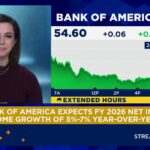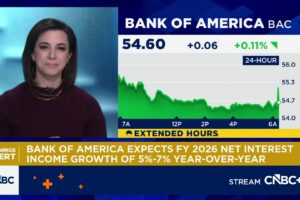We recently published a list of Top 10 Trending AI Stocks in Q4. In this article, we are going to take a look at where NVIDIA Corporation (NASDAQ:NVDA) stands against other top trending AI stocks in Q4.
As LLMs continue to hog data from the open internet for training, publishers are growing concerned about their intellectual property and compensation. In a latest development, The New York Times issued a cease and desist letter to Perplexity to stop using its data for training without permission.
Gene Munster of Deepwater Asset Management, while talking about this news on CNBC, said that these developments could prove “horrendous” for LLMs in the short term.
“The short-term economics for these large language models is horrendous, and so, I think it changes from bad to worse in the short term. I just want to put some quick context around those numbers. Right now, OpenAI pays NewsCorp about $50 million. They’re going to do about $4 billion in revenue this year and $11 billion next year, so, I mean, it’s measurable.”
However, Munster thinks in the long term, these licensing deals would not impact major LLM companies negatively given the ROI they’d be enjoying.
READ ALSO 7 Best Stocks to Buy For Long-Term and 8 Cheap Jim Cramer Stocks to Invest In
The analyst also made a prediction about Perplexity. He believes the company would be acquired because it’s competing with a lot of “big guns.” He quoted Oracle’s Larry Ellison who said that it takes about $100 billion to be a “proprietary” large language model.
“So, you look at the $6 billion at OpenAI, and you need to be raising in chunks of billions, not millions. Understand that it’s a big raise for a private company that’s moving quickly, but they’re going to get acquired. They’re just up against too many other big guns here to try to get to those coveted four or five spots of the LLM landscape.”
For this article we picked 10 AI stocks trending based on latest news. With each company we have mentioned its hedge fund sentiment. Why are we interested in the stocks that hedge funds pile into? The reason is simple: our research has shown that we can outperform the market by imitating the top stock picks of the best hedge funds. Our quarterly newsletter’s strategy selects 14 small-cap and large-cap stocks every quarter and has returned 275% since May 2014, beating its benchmark by 150 percentage points (see more details here).
A close-up of a colorful high-end graphics card being plugged in to a gaming computer.
Number of Hedge Fund Investors: 179
BofA increased Nvidia Corp (NASDAQ:NVDA)’s full-year 2025 earnings estimate to $2.87 per share from $2.81, lifted the 2026 estimate to $4.47 from $3.90, and adjusted the 2027 estimate to $5.67 from $4.72. The firm also maintained its Buy rating and raised its price target to $190, up from $165. Nvidia shares have approached new highs this week.
“We see NVDA’s free cash flow generation, with a 45-50%+ margin, as underappreciated, nearly double the 23-25% average of the Mag-7,” said BofA analysts, led by Vivek Arya, in a note. “In dollar terms, NVDA could generate over $200 billion in free cash flow over the next two years, putting it in the same league as Apple (AAPL) and giving it room to grow.” BofA also pointed to Nvidia Corp (NASDAQ:NVDA)’s increasing role in enterprise collaborations with companies like Accenture (ACN), ServiceNow (NOW), and Microsoft (MSFT)
Nvidia Corp (NASDAQ:NVDA) holds a commanding 80% to 85% share in a $400 billion market, which has prompted BofA Securities to raise its earnings forecasts for the company.
Nvidia’s declines after the Q2 results were more or less expected amid Blackwell delay reports confirmed by management. However, the delays were mainly due to a change in Blackwell GPU mask. That does not affect the main functional logic or design of the chip, according to analysts. While Blackwell has been delayed for a few months, it does not change the core growth thesis for Nvidia.
Nvidia is set to see huge growth on the back of the data center boom amid the AI wave.
At Nvidia’s GPU Technology Conference in March 2024, CEO Jensen Huang estimated annual spending on data center infrastructure at about $250 billion. Over the next decade, this could total between $1 trillion and $2 trillion, depending on how long this level of investment continues. During the same Q&A session, Bank of America’s Vivek Arya echoed this estimate, suggesting the total addressable market would fall in the $1-2 trillion range, particularly as countries invest in their own AI infrastructure. By the end of the decade, spending could be at the high end of that range.
Of course, Nvidia won’t dominate the entire $2 trillion opportunity, as it faces competition from companies like AMD and internally developed AI accelerators from Google, Amazon, and even Apple. Some analysts believe Nvidia’s data center market share between 2025 to 2029 will be over $950 billion—less than half of the total market—but still enough to make it the leader in the sector.
Vltava Fund stated the following regarding NVIDIA Corporation (NASDAQ:NVDA) in its Q3 2024 investor letter:
“Over the summer, we devoted a lot of time to studying the AI-related investment wave. This spans a wide range of sectors and our view could be very briefly summarised as follows: The first-tier beneficiaries are primarily companies in the semiconductor sector, NVIDIA Corporation (NASDAQ:NVDA) perhaps the most. That company is benefiting from the huge increase in investment by large technology companies to build enormous data centres. We know who NVIDIA’s customers are. They are companies like Meta, Alphabet, Amazon, and Microsoft. They are investing hundreds of billions of dollars into their AI capabilities. What is not entirely clear, however, is who are and will be the customers of NVIDIA’s customers, and, more importantly, when, and if, they will be able to come up with such huge demand for AI services that the profits from AI will justify and pay for the enormous investments all these companies have been making. The further we move away from the starting point that NVIDIA represents in our more broadly-reaching estimates, the lessreliable those estimates are.So far, we know just one thing for sure, and that is that investments in AI capabilities are ongoing and they are huge. They are not only bringing large demand to chipmakers and the semiconductor sector but to some other sectors as well. Indeed, building AI clusters also requires the construction of new semiconductor factories, new energy sources, and all the associated infrastructure. The numbers under consideration are incredibly high. It is possible that over the next decade the construction of AI centres will necessitate a 20% increase in US energy consumption. The investment required will be measured not in the hundreds of billions of dollars, but in an order of magnitude higher. Maybe two orders of magnitude.”
Overall, NVDA ranks 4th on our list of top trending AI stocks in Q4. While we acknowledge the potential of NVDA, our conviction lies in the belief that under the radar AI stocks hold greater promise for delivering higher returns, and doing so within a shorter timeframe. If you are looking for an AI stock that is more promising than NVDA but that trades at less than 5 times its earnings, check out our report about the cheapest AI stock.
READ NEXT: 8 Best Wide Moat Stocks to Buy Now and 30 Most Important AI Stocks According to BlackRock.
Disclosure: None. This article is originally published at Insider Monkey.








